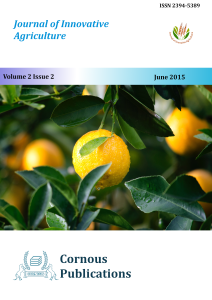Field experiments were conducted to investigate the effects of graded levels of fly ash with SSB and FYM on the incidence of rice stem borer (Scirpophaga incertulas) (Lepidoptera: Pyralidae) in rice crop in low and high Si soils under split plot design. The graded levels of fly ash incorporated in soil at five levels (0, 25, 50, 75 and 100 t/ha) one week before crop transplantation. It was found that fly ash had significant influence on the stem borer population over the control. On an average, with respect to borer incidence, higher dose of fly ash @ 100 t ha-1 markedly decreased infestation (16.9%) while, applications at 25 and 50 t ha-1 permitted slightly more dead hearts incidence, but differed significantly from control. In main plot treatments application of SSB + FYM recorded 16.1 per cent of stem borer incidence. In interaction application of fly ash @ 100 t ha-1 with SSB + FYM reported less per cent of dead hearts. Application of fly ash @ 100 t/ha had significant effect with meagre pest incidence of 11.6 per cent. Besides application of SSB and SSB+FYM alone played a major role in maintaining ETL of stem borer. The present study implies that due to suppressive effects of Si and K present in fly ash the incidence of the rice stem borer mitigated at crop vegetative stage and the use of soil incorporation strategy can create an unfavourable condition for pests to survive.
An investigation was carried out in 23 advanced lines of sorghum along with M-35-1, Muguthi, E-36-1 and SPV-86 as check varieties. Various genetic diversity parameters were studied for 14 quantitative characters viz., Root Length, Root Spread, Seminal Roots, Adventitious Roots, Fresh Root Weight, Root Volume, Dry Root Weight, Seed Yield per Plant, Fodder Yield per plant, Charcoal rot Lodging per cent, Mean Node Crossed, Mean Length Spread, Phytic Acid and Inorganic Phosphorus. Twenty Seven sorghum lines were analyzed for D2 analysis. They grouped into 6 different clusters. Cluster I was largest with seven genotypes followed by cluster II and V with six genotypes. Whereas cluster III consisted of four genotypes, while two genotypes were present in cluster IV and cluster VI. The intra cluster distance was maximum in cluster V followed by cluster III and cluster II. Whereas inter clusters distance was maximum between cluster IV and cluster VI. All two genotypes from cluster IV were characterized by high root length, fresh root weight, dry root weight, less charcoal rot infection of both Mean Node Cross and Mean Length Spread. While cluster VI was characterized by root volume and high inorganic phosphorus. These characters are important with respect to overall improvement seed yield combining with charcoal rot resistance and high inorganic phosphorus in sorghum. Crosses among genetically diverse genotypes are likely to throw desirable recombinants. Therefore crossing between the genotypes belonging to cluster IV (GS 21 and Muguthi) and cluster VI (GS-14 and M-35-1) might be useful for identifying recombinants for high yield potential in segregating generations.
A total number of 39 genotypes were evaluated for popping characters and 53 genotypes were evaluated for flaking traits which are released varieties, Hybrids and improved cultures. Observations on 500 grain weight, grain volume, density of the grains volume of the grain after imbibitions, diameter of the grains, 500 popped grain weight, number of unpopped grains, diameter of the popped grains, density of popped grains and volume of the flour per kilogram of grain were recorded for popping qualities and observations on 500 grain weight, grain volume, density of the grains diameter of the grain, 500 flaked grain weight, diameter of the flaked grain, volume of 500 flaked grains and density of the flaked grains were recorded for flaking traits. Based on the mean performance the entries TKSV 0802, TKSV 0808 and TKSV 0809 are promising for popping characters and TKSV 0801, TKSV 0804, TKSV 0809, TKSV 0816, TNS 607, TNS 618, Co (S) 28, K 4 TWC 100 and TWC 120 are promising for flaking traits. A strong positive correlation were noticed for all the popping traits with volume of flour for ½ kilogram of grains except 500 popped grain weight for which a non significant positive correlation were noticed. A significant positive correlation were noticed with density of the flaked grains and grain volume, density of grains, diameter of grains and volume of 500 flaked grains. The above results enable to screen and identify sorghum genotypes suitable for popping and flaking types from a large number of genotype cultivated in the country.
By utilizing the Southwest and Northeast monsoon seasonal rainfall data of 90 years (1911-2000) of 32 districts of Tamil Nadu leaving Chennai district, combo analyses (combined analysis) were made between moisture index values to find out the seasonal soil moisture stress status by using Thornthwaite and Mather (1955) moisture index. Paired t- test and correlation tools were used to evaluate the link between the two seasonal moisture stresses. The results on combo analysis made from moisture indices of both Southwest monsoon and Northeast monsoon of the same year, it was found from the paired t-test analysis that all the districts except Coimbatore did vary for their soil moisture status, while it was inferred from the results of correlation analysis that, all the districts did not vary for soil moisture stress except the district Perambalur. In respect of combo analysis made between the moisture indices of Northeast Monsoon of the previous year and the Southwest Monsoon of the succeeding year, the result from paired t- test revealed the similar findings that were observed for the combo analysis made between both Southwest monsoon and Northeast monsoon of the same year. In respect of correlation study except Tirunelveli district, the entire district did not vary significantly. Accordingly, crop plan agenda is suggested from the literature.
